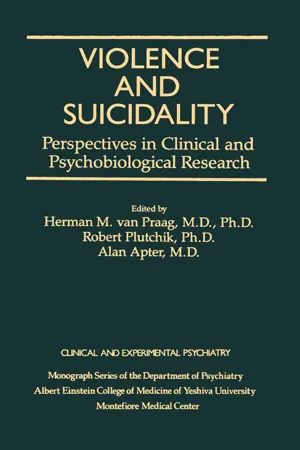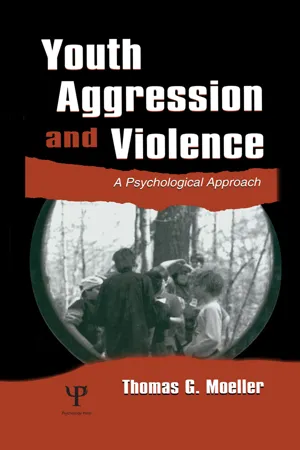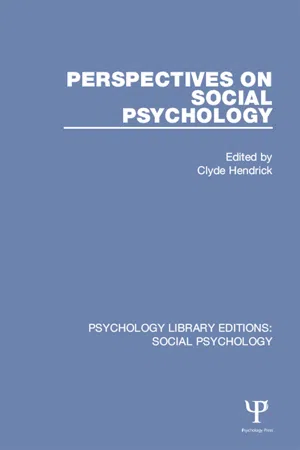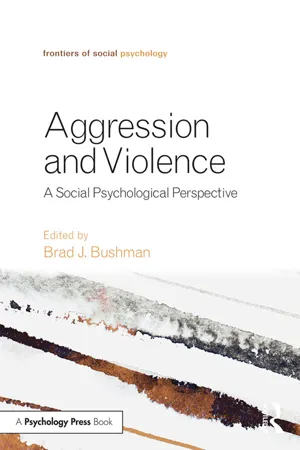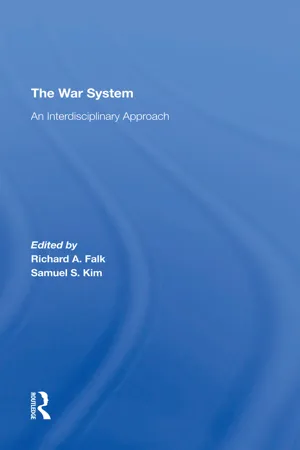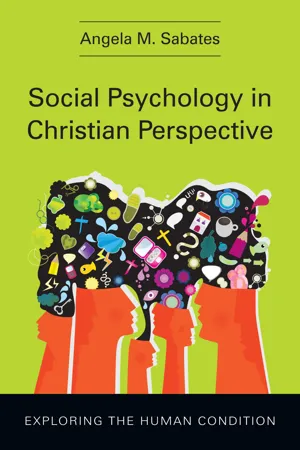Psychology
Ethological Explanations of Aggression
Ethological explanations of aggression focus on understanding aggressive behavior in animals and humans from an evolutionary perspective. These explanations emphasize the role of genetics, instinct, and natural selection in shaping aggressive behaviors. Ethologists study how aggression contributes to survival, reproduction, and social organization within different species, shedding light on the adaptive functions of aggressive behavior.
Written by Perlego with AI-assistance
Related key terms
Related key terms
1 of 4
Related key terms
1 of 3
9 Key excerpts on "Ethological Explanations of Aggression"
- eBook - ePub
The Social Psychology of Aggression
3rd Edition
- Barbara Krahé(Author)
- 2020(Publication Date)
- Routledge(Publisher)
Chapter 12 of this volume). Given that there is little support for Lorenz’s ethological model as an explanation of human aggression, you may wonder why it has been presented here at all. The reason is that it still remains widely popular in everyday discourse when people suggest explanations, and indeed cures, for aggression. Enabling readers to participate in this discourse well-equipped with critical arguments to challenge popular myths about aggression is one of the goals of the present volume.The sociobiological view: Aggression as a product of natural selection
Sociobiology is concerned with analysing the biological foundation of social behaviour on the basis of the evolutionary principle of natural selection . This approach also offers an explanation of aggression in both humans and animals, focusing on the long-term, “ultimate” mechanisms that shape and promote aggression through the generations. Rooted in Darwin’s (1859) theory on “the origin of species”, evolutionary theory is based on the idea that in order for a behaviour to be genetically transmitted within a species, it has to be adaptive . Behaviours are adaptive to the extent that they increase the chances of survival of the species as a whole in the environment in which it lives.sociobiology: discipline devoted to the study of the evolutionary basis of social behaviour.Concise presentations of the evolutionary thinking about social behaviour have been provided by Daly and Wilson (1994) and Buss and Shackelford (1997). Applying the principle of evolution through natural selection to the study of aggression, aggressive behaviour directed at fighting off attackers as well as rivals in mate selection is seen as adaptive in the sense of enhancing the reproductive success of the aggressor (Archer, 1995). Because they are better able to control access to female mating partners, the more aggressive members of a species are more successful in passing their genes on to the next generation, thus favouring the natural selection of aggressive behaviour. Their genetic make-up slowly spreads at the expense of less aggressive, and therefore less reproductively successful, members. However, aggression may be a potentially costly and maladaptive behaviour in certain cases. For example, attacking an opponent of superior fighting power entails the risk of being killed. Therefore, the functional mechanism seen as driving the evolution of aggressive behaviour is a cost–benefit calculus (Archer, 2009; Georgiev, Klimczuk, Traficonte, & Maestripieri, 2013). As it would be maladaptive to engage in aggressive behaviour when the risk of being overpowered and potentially killed by the opponent is high, it is functional from the point of view of reproductive success to withdraw from confrontations that involve an opponent of superior strength and fighting power. - Paul Seager(Author)
- 2014(Publication Date)
- Teach Yourself(Publisher)
Biological explanations for aggressionHaving looked at some of the issues to be resolved when studying aggression systematically, it is now possible to look at two general approaches – biological explanations (nature) vs. learning explanations (nurture) – which have attempted to account for why people behave aggressively.This approach takes the form of ‘instinct theories’ of aggression which explain why humans have an innate need to aggress. According to Freud, aggression is inevitable, and his early psychodynamic theory suggested that it was a reaction to frustration experienced in pursuit of pleasure and the satisfaction of the libido. He later modified his idea to allege that, alongside the desire for self-preservation, referred to as Eros (the life instinct), there was a second instinct more focused on destruction, referred to as Thanatos (the death instinct). He claimed that this destructive aggressive energy needed to be continually turned away from the individual towards the outside, in order to prevent self-destruction: aggressive behaviour thus serves as an outlet when Eros and Thanatos are in conflict. This is sometimes referred to as a hydraulic model – aggression is a way of dissipating the build-up of pressure. From Freud’s model we get the idea of catharsis, whereby hostility and aggression are diffused in a non-destructive way.Key idea: Eros and ThanatosAccording to psychodynamic theory, to protect Eros (the life instinct) within an individual, the destructive energies of Thanatos (the death instinct) must be continually deflected away, and this manifests outwardly as aggression.Another biological theory of aggression, similar to Freud’s theory in as much that it is a hydraulic model, comes from Lorenz, who believed that aggression has a species serving function. Lorenz claimed that aggression is an innate behavioural disposition which derives from the idea of natural selection, and increases the species’ chance of survival. The potential for conflict leads to geographical dispersion which has the effect of ensuring that members of the same species have sufficient resources to survive and flourish. Applying an animal model to humans, he claimed that hierarchies developed and fights between rivals ensured selection of the strongest and healthiest to lead. Ultimately, aggression builds up and needs to be released in a socially acceptable way (hence it is referred to as a hydraulic model). In animals this is done through threat displays and the ritualization of aggression; very rarely do fights lead to permanent injury or death due to their use of appeasement gestures. It is questionable whether this model can really be applied to humans, who have developed weapons that can kill from a distance.- eBook - ePub
Violence And Suicidality : Perspectives In Clinical And Psychobiological Research
Clinical And Experimental Psychiatry
- Herman M. Van Praag, Robert Plutchik, Alan Apter, Herman M. Van Praag, Robert Plutchik, Alan Apter(Authors)
- 2014(Publication Date)
- Routledge(Publisher)
This essay attempts to point the way towards an integration of the approaches of the biologist and the social scientist in the study of aggression. The term biology, so often interpreted in American science to mean only physiology, embraces also the theory of evolution. Can the theory of evolution help us to understand human aggression? This issue can be discussed only briefly here, but an answer is implicit in much of what has been said. On the one hand, man is endowed with the potential for aggressive behavior, and it is reasonable to suppose that aggressive propensities have been shaped by natural selection. This does not mean that humans are inevitably aggressive, for natural selection operates to produce propensities which can lead to action as appropriate, and has given us the ability to cooperate as well as to compete and to behave aggressively. Whilst there can be no proof of the role of natural selection in shaping the details of human aggression, an evolutionary approach does help to integrate what otherwise appear as isolated facts. For instance our greater propensity to behave aggressively towards strangers than towards known individuals, and toward non-kin as opposed to kin, might well have been adaptive in our environment of evolutionary adaptedness.An evolutionary perspective is even suggestive over questions concerning the ontogeny of aggression. Why should it be that having parents who are cold and harshly controlling in childhood should predispose individuals to aggression and to behavior problems in adolescence? Is it because natural selection has operated so that individuals adopt a developmental trajectory that will fit them for (biological) success in the environment they will encounter in adulthood, and the best predictor of that environment is the childhood one? Are children brought up in loving, authoritative families less likely to be aggressive because cooperation is likely to be a better subsequent strategy? Such an approach would also suggest that natural selection would have produced some flexibility consequent upon post-infancy pre-adulthood experience, a suggestion compatible with the data. Whilst the role of natural selection here can be no more than a matter of speculation, critically applied it can integrate a surprising wealth of facts about human behavior and human relationships (Hinde, 1987). - eBook - ePub
- Peter Ainsworth(Author)
- 2012(Publication Date)
- Willan(Publisher)
Some appear to support Freud’s viewpoint by suggesting that aggression is an innate driving force in the sense that it has some survival value. To put it bluntly, humans who are unable to defend themselves against physical threats are unlikely to live long enough to be able to procreate. In other words whilst aggressive tendencies may lead to the killing of large numbers of others, they may also ensure the survival of the species as a whole. For example, Lore and Schultz (1993) have suggested that aggression is a common feature in the lives of most animal species for the simple reason that it has some survival value.A similar view has been expressed by Buss and Kenrick (1998), who offer some support for this sociobiological perspective on aggression. However, even writers such as these agree that most animals have also developed mechanisms that enable them to suppress such aggressive instincts when it is in their interests to do so. For example if we are threatened by an extremely large and aggressive-looking man carrying a gun, it may be in our interests to suppress our desire to behave aggressively towards this person. Thus it is suggested that, even in the most violent species, aggression remains an option rather than an automatic response as Freud had originally suggested. Most commentators would agree that while approaches such as those of the sociobiologists may shed some light on the biological underpinnings of aggression, they are in themselves insufficient to explain the myriad aggressive behaviours of which humans are capable.Aggression as a response to external stimuliEarlier in this chapter we suggested that in many cases aggression arises as a result of provocation. There are, however, other events or situations that might trigger the aggressive response. One of these is the experience of frustration. Such a suggestion was first made by Dollard and his colleagues more than 60 years ago when they developed the frustration aggression hypothesis (Dollard et al - eBook - ePub
Youth Aggression and Violence
A Psychological Approach
- Thomas G. Moeller(Author)
- 2001(Publication Date)
- Routledge(Publisher)
social aggression (in which the target is another’s self-esteem or social status, but not necessarily another’s social relationships; Crick et al., 1999).Aggression can also be hostile, instrumental, or reactive. Hostile aggression has the primary goal of doing harm to the victim or of making the victim suffer, whereas instrumental aggression involves the use of force in order to obtain some nonaggressive goal (such as when one child beats up another child in order to take some money). Reactive aggression refers to an angry aggressive act in response to some precipitating environmental event or behavior. Instrumental aggression is sometimes referred to as unprovoked aggression, whereas reactive aggression is also called provoked aggression (Bartol, 1995; Dodge, Coie, Pettit, &C Price, 1990; Olweus, 1986).Theories of Aggression
A variety of psychological theories have been developed in an attempt to explain why children become aggressive. We now examine some of these theoretical explanations.Genetic and Biological Theories of Aggression
A number of theories have postulated that aggression is due to either genetic or biological factors. Genetic theories argue that aggressiveness (or at least the basis for aggressiveness) is transmitted by means of genetic inheritance from one generation to the next. Biological theories attempt to specify the biological processes and mechanisms by which genetic factors and innate characteristics get translated into actual aggressiveness. We examine these issues in more detail in chapter 4 .Freud’s Theory
Freud, too, held that aggression is rooted in biology. According to him, humans are born with a drive (called the Thanatos) that seeks the cessation of life (see Feshbach, 1970, for a discussion). Although the Thanatos might be directed toward the self (thus resulting in self-injury or even death), it can also be discharged toward others (thus resulting in aggression). Freud also believed that the strength of the Thanatos builds up gradually and that, when its strength hits a certain level (or threshold), it demands to be discharged. One way of discharging the Thanatos is through the defense mechanism of sublimation, - eBook - ePub
- Clyde Hendrick(Author)
- 2015(Publication Date)
- Psychology Press(Publisher)
Nevertheless, the position of Geoffroy-Saint-Hilaire impressed some, and a series of biologists espoused the same arguments well into the early decades of the twentieth century (see the reviews of Eibl-Eibesfeldt, 1970; Mortenson, 1975). It was not until the 1930s, however, that ethology received an impetus that changed it from the concern of a splinter group of biologists to what it is today. That impetus stemmed from the empirical and theoretical work of Lorenz and Tinbergen and their associates. Interestingly, it seems that this circle of modern ethologists were not aware of the origins of the label they had applied to themselves, nor of the earlier debates (Jaynes, 1969). Regardless, it was an appropriate selection as the aim of ethology today is the same as it was in the past, the understanding of phylogenetically adapted behavior of organisms in their natural habitat.In 1951, Tinbergen provided the first systematic and comprehensive exposition of the distinguishing features and principles of ethology. With few exceptions, these principles remain current with ethologists, although as Hinde (1970, p. vii) points out, the term ethologist is most correctly applied to students of behavior who share certain orienting attitudes, rather than the same problems, methods, or levels of analysis (see also Crook, 1970, for a contemporary overview). The following compendium has been drawn from several ethologically writers (Eibl-Eibesfeldt, 1967, 1970; Hess, 1970a, 1970b; Hinde, 1970, 1974; Lorenz, 1937, 1950, 1965; Thorpe, 1956; Tinbergen, 1948, 1951, 1963) who appear to be in general agreement on main issues.In the broadest sense, ethologists claim to concern themselves equally with evolution, adaptation (survival), ontogeny (development), and immediate causation and organization of behavior. Much interest has centered on the last topic in the list. Ethological theory has provisions to account for the organization of an organism’s behavior through the interaction of inherited internal factors and external environmental factors. In an extreme sense, behavior can be reactive in that it is controlled, within limits, by environmental stimulation. On the other extreme, behavior can be spontaneous in that it is caused by neurophysiological activities or states that are largely independent of external stimulation. Most often, of course, behavior is a product of an interplay between these conceptually distinct causal forces. - eBook - ePub
Aggression and Violence
A Social Psychological Perspective
- Brad J. Bushman(Author)
- 2016(Publication Date)
- Routledge(Publisher)
It is commonly accepted in biology that, throughout the animal kingdom, aggression is one of the most widespread and functional forms of social behavior that ultimately contributes to fitness (procreation) and survival of individuals. Clearly, aggression is the behavioral weapon of choice for both animals and humans to defend themselves and their offspring, secure food and mates, compete for limited resources, and maintain social status/hierarchies. Although most individuals engage in social conflicts with appropriate and well-controlled (functional) forms of aggressive behavior, a relatively small fraction of individuals can become violent. However, this small percentage of violent individuals is a major source of death and injury, and they constitute one of the most significant problems for public health, medical institutions, and criminal justice systems. Violent individuals inflict a terrible burden on human societies. These violent, hostile, and presumably less adaptive forms of aggression observed in our human society and clinically, comorbid across a wide spectrum of DSM-defined psychiatric and neurological disorders, have motivated much of the scientific interest in aggressive behavior in animals. In particular, there is a need to understand these problematic behaviors in terms of their underlying causal mechanisms and modulating factors. In general, animal models are essential to obtain experimental support of the causal nature of physiological and environmental factors. As a matter of fact, a considerable part of our current knowledge on the ethology, etiology, neurobiology, genetics, and pharmacology of this behavior is based on experimental and laboratory studies of aggressive behaviors in a wide variety of animals (e.g., fruit flies, honeybees, ants, crickets, zebra fish, songbirds, mice, rats, hamsters, prairie voles, dogs, cats, monkeys).Most neurobehavioral and pharmacological studies of aggressive behavior in the laboratory setting are performed in rodent species (rats, voles, and mice) that can show high levels of territorial aggression characteristic of their generally dispersive social structure under low population densities in their natural habitats. Therefore, much of the preclinical aggression research is conducted in territorial male resident rats/mice confronting an intruder of the same species (called a “conspecific”). This so-called resident-intruder paradigm allows the spontaneous and natural expression of both offensive aggression and defensive behavior in laboratory rodents in a semi-natural laboratory setting. By recording the frequencies, durations, latencies, and temporal and sequential patterns of all the observed behavioral acts and postures in the combatants during these confrontations, a detailed quantitative picture (ethogram) of offensive (resident) and defensive (intruder) aggression is obtained. The resident-intruder paradigm brings this natural form of behavior into the laboratory, allowing controlled studies of both the resident aggressor and the intruder victim (Koolhaas et al., 2013). The paradigm is strongly based on the fact that an adult male rat will establish a territory when given sufficient living space. Territoriality is significantly enhanced in the presence of females and/or sexual experiences. As a consequence of territoriality, the resident will attack unfamiliar males intruding in its home cage. The intruder in turn will show defensive behavior in response to the offensive attack by the resident. Although typical patterns of aggressive behavior differ between species, there are several concordances in the ethology and neurobiology of aggression among rodents, primates, and humans. - eBook - ePub
The War System
An Interdisciplinary Approach
- Richard Falk, Samuel S Kim(Authors)
- 2019(Publication Date)
- Routledge(Publisher)
However, there are different causal variables of animal aggression. The heritability of aggressiveness in dogs and leghorn chickens has been demonstrated through selective breeding (Corning 1973). It is also argued that frustration is as much a source of aggression in animals as it is in children and adults (Berkowitz 1968b; Durbin and Bowlby 1968). The social conditions of rearing are also believed to influence the probability of aggression in "intra-species encounters in mice, cats, dogs, monkeys, and other animals" (Hinde 1973:99). Despite the differences in emphasis on the etiological variables of agonistic behavior, there is little doubt now that the causes of animal aggression are not as simple as the Lorenzians would have us believe and that the stimuli evoking aggressive responses can be ecological, social, experiential, genetic, hereditary, hormonal, and even psychological (perceptual). Can animal research shed light on human behavior in general and human aggression in particular? By repeatedly stressing our common origin with animals, the Lorenzians ignore the crucial fact that contemporary monkeys and apes are not the equivalents of human ancestors (Washburn and Hamburg 1973:64). Without direct fossil evidence for the evolution of behavior, we cannot make an inductive leap from contemporary primates to our hominid ancestors nor from the latter to contemporary man. Even in physiological attributes, contemporary man is unique. For his brain has "enlarged from roughly 500 cc 1.75 million years ago to about 1450 cc at present" (Holloway 1968:43) - eBook - ePub
Social Psychology in Christian Perspective
Exploring the Human Condition
- Angela M. Sabates(Author)
- 2012(Publication Date)
- IVP Academic(Publisher)
Studies of biological explanations of aggression investigate such factors as brain structure and function, behavioral genetics, and evolutionary traits. It is important to note that biological aspects of aggression cannot be separated from situational, social-cultural and emotional factors for any particular instance. Thus it is important to keep in mind that, just because scientists can identify specific parts of the brain that are related to aggressive responses, one must be careful not to assume that biology is the whole story. Also as you read the following sections wherein specific biological findings are discussed, keep in mind that the brain is actually a complex system where all the parts interact with each other. Hence, the finding that aggression seems related to one brain area also suggests that other related brain areas are likewise involved.Prefrontal cortex. Studies examining the biological aspects of aggression suggest that it is often linked to impairments in the prefrontal cortex of the brain. The prefrontal cortex handles what are called executive cognitive processes, which include higher-order thinking related to reasoning, impulse control and understanding the consequences of one’s behavior (Nelson, 2005). Neurological studies using MRIs and PET scans have demonstrated that aggressive individuals of all ages often have reduced metabolism and less volume in the prefrontal cortex (Raine, 1997, 2002).Clinical studies of brain-damaged subjects suggest that impairments in the prefrontal cortex may be related to higher levels of aggression. For example, Grafman et al. (1996) demonstrated that Vietnam veterans with prefrontal ventromedial brain injuries displayed more aggression, especially verbal aggression, after the head injury. However, not all individuals with acquired prefrontal ventromedial lesions become aggressive (Ellenbogen et al., 2005).The amygdala. The amygdala
Index pages curate the most relevant extracts from our library of academic textbooks. They’ve been created using an in-house natural language model (NLM), each adding context and meaning to key research topics.
Explore more topic indexes
Explore more topic indexes
1 of 6
Explore more topic indexes
1 of 4


